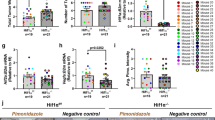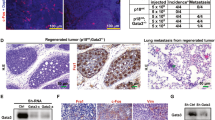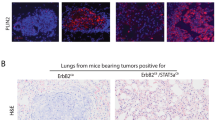Abstract
Overexpression of hepatocyte growth factor (HGF), also called scatter factor (SF), and its receptor c-Met are associated with poor prognosis for cancer patients. In particular, breast cancer cells can produce HGF that acts in a paracrine as well as in an autocrine manner. Therefore, HGF and c-Met are putative targets for cancer therapy. To explore HGF/c-Met signaling in breast cancer, we have generated transgenic mice expressing HGF specifically in mammary epithelium under the transcriptional control of the whey acidic protein (WAP) gene promoter. WAP-HGF transgenic females developed hyperplastic ductal trees and multifocal invasive tumors after several pregnancies, some of which progressed to lung metastases. Tumors produced HGF and displayed phosphorylated c-Met, which correlated with increased Akt as well as c-myc activation. A high growth rate, as demonstrated by Ki67 nuclear antigen staining, and a lack of progesterone receptor were characteristic of the tumors. Immunohistochemical analysis revealed areas of osteopontin (Opn) expression in WAP-HGF tumors and lung metastases in agreement with a previously reported role for Opn in invasive growth. We suggest that these mice may serve as a new breast cancer model for the evaluation of the effects of unscheduled HGF expression in breast cancer.
This is a preview of subscription content, access via your institution
Access options
Subscribe to this journal
Receive 50 print issues and online access
$259.00 per year
only $5.18 per issue
Buy this article
- Purchase on Springer Link
- Instant access to full article PDF
Prices may be subject to local taxes which are calculated during checkout







Similar content being viewed by others
References
Aulmann S, Bentz M and Sinn HP . (2002). Breast Cancer Res. Treat., 74, 25–31.
Bieche I, Champeme MH and Lidereau R . (1999). Int. J. Cancer, 82, 908–910.
Birchmeier C and Gherardi E . (1998). Trends Cell. Biol., 8, 404–410.
Boon EM, van der Neut R, van de Wetering M, Clevers H and Pals ST . (2002). Cancer Res., 62, 5126–5128.
Bowers DC, Fan S, Walter KA, Abounader R, Williams JA, Rosen EM and Laterra J . (2000). Cancer Res., 60, 4277–4283.
Camp RL, Rimm EB and Rimm DL . (1999). Cancer, 86, 2259–2265.
Cui X, Zhang P, Deng W, Oesterreich S, Lu Y, Mills GB and Lee AV . (2003). Mol. Endocrinol., 17, 575–588.
Danilkovitch-Miagkova A, Miagkov A, Skeel A, Nakaigawa N, Zbar B and Leonard EJ . (2001). Mol. Cell. Biol., 21, 5857–5868.
Di Renzo MF, Olivero M, Giacomini A, Porte H, Chastre E, Mirossay L, Nordlinger B, Bretti S, Bottardi S and Giordano S . (1995). Clin. Cancer Res., 1, 147–154.
Di Renzo MF, Olivero M, Martone T, Maffe A, Maggiora P, Stefani AD, Valente G, Giordano S, Cortesina G and Comoglio PM . (2000). Oncogene, 19, 1547–1555.
Edakuni G, Sasatomi E, Satoh T, Tokunaga O and Miyazaki K . (2001). Pathol. Int., 51, 172–178.
Elliott BE, Hung WL, Boag AH and Tuck AB . (2002). Can. J. Physiol. Pharmacol., 80, 91–102.
Furge KA, Zhang YW and Vande Woude GF . (2000). Oncogene, 19, 5582–5589.
Gallagher RC, Hay T, Meniel V, Naughton C, Anderson TJ, Shibara H, Ito M, Clevers H, Noda T, Sanson OJ, Mason JO and Clarke AR . (2002). Oncogene, 21, 6446–6457.
Ghoussoub RA, Dillon DA, D'Aquila T, Rimm EB, Fearon ER and Rimm DL . (1998). Cancer, 82, 1513–1520.
Greenberg R, Schwartz I, Skornick Y and Kaplan O . (2003). Breast Cancer Res., 5, R71–R76.
Hennighausen L and Robinson GW . (2001). Dev. Cell, 1, 467–475.
Hogan B . (1994). Manipulating the Mouse Embryo: A Laboratory Manual. Cold Spring Harbor Laboratory Press: Plainview, NY.
Jin L, Fuchs A, Schnitt SJ, Yao Y, Joseph A, Lamszus K, Park M, Goldberg ID and Rosen EM . (1997). Cancer, 79, 749–760.
Kamalati T, Niranjan B, Yant J and Buluwela L . (1999). J. Mammary Gland Biol. Neoplasia, 4, 69–77.
Kang JY, Dolled-Filhart M, Ocal IT, Singh B, Lin CY, Dickson RB, Rimm DL and Camp RL . (2003). Cancer Res., 63, 1101–1105.
Knuefermann C, Lu Y, Liu B, Jin W, Liang K, Wu L, Schmidt M, Mills GB, Mendelsohn J and Fan Z . (2003). Oncogene, 22, 3205–3212.
Kordon EC, Smith GH, Callahan R and Gallahan D . (1995). J. Virol., 69, 8066–8069.
Liang J, Zubovitz J, Perrocelli T, Kotchetkov R, Connor MK, Han K, Lee JH, Ciarallo S, Catzavelos C, Beniston R, Franssen E and Slingerland JM . (2002). Nat. Med., 8, 1153–1160.
Liu X, Robinson GW and Hennighausen L . (1996). Mol. Endocrinol., 10, 1496–1506.
Medico E, Gentile A, Lo Celso C, Williams TA, Gambarotta G, Trusolino L and Comoglio PM . (2001). Cancer Res., 61, 5861–5868.
Michaelson JS and Leder P . (2001). Oncogene, 20, 5093–5099.
Miyoshi K, Shillingford JM, Le Provost F, Gounari F, Bronson R, von Boehmer H, Taketo MM, Cardiff RD, Hennighausen L and Khazaie K . (2002). Proc. Natl. Acad. Sci. USA, 99, 219–224.
Monga SP, Mars WM, Pediaditakis P, Bell A, Mule K, Bowen WC, Wang X, Zarneger R and Michalopoulos GK . (2002). Cancer Res., 62, 2064–2071.
Nakopoulou L, Gakiopoulou H, Keramopoulos A, Giannopoulou I, Athanassiadou P, Mavrommatis J and Davaris PS . (2000). Histopathology, 36, 313–325.
Nemir M, Bhattacharyya D, Li X, Singh K, Mukherjee AB and Mukherjee BB . (2000). J. Biol. Chem., 275, 969–976.
Niemann C, Brinkmann V, Spitzer E, Hartmann G, Sachs M, Naundorf H and Birchmeier W . (1998). J. Cell Biol., 143, 533–545.
Niranjan B, Buluwela L, Yant J, Perusinghe N, Atherton A, Phippard D, Dale T, Gusterson B and Kamalati T . (1995). Development, 121, 2897–2908.
Oates AJ, Barraclough R and Rudland PS . (1996). Oncogene, 13, 97–104.
Pennacchietti S, Michieli P, Galluzzo M, Mazzone M, Giordano S and Comoglio PM . (2003). Cancer Cell, 3, 347–361.
Pittius CW, Hennighausen L, Lee E, Westphal H, Nicols E, Vitale J and Gordon K . (1988). Proc. Natl. Acad. Sci. USA, 85, 5874–5878.
Pollard JW . (2001). Breast Cancer Res., 3, 230–237.
Rahimi N, Tremblay E, McAdam L, Park M, Schwall R and Elliott B . (1996). Cell Growth Differ., 7, 263–270.
Rittling SR and Novick KE . (1997). Cell Growth Differ., 8, 1061–1069.
Robinson GW, McKnight RA, Smith GH and Hennighausen L . (1995). Development, 121, 2079–2090.
Rong S, Segal S, Anver M, Resau JH and Vande Woude GF . (1994). Proc. Natl. Acad. Sci. USA, 91, 4731–4735.
Rosner A, Miyoshi K, Landesman-Bollag E, Xu X, Seldin DC, Moser AR, MacLeod CL, Shyamala G, Gillgrass AE and Cardiff RD . (2002). Am. J. Pathol., 161, 1087–1097.
Rudland PS, Platt-Higgins A, El-Tanani M, De Silva Rudland S, Barraclough R, Winstanley JH, Howitt R and West CR . (2002). Cancer Res., 62, 3417–3427.
Schlotter CM, Vogt U, Bosse U, Mersch B and Wassmann K . (2003). Breast Cancer Res., 5, R30–R36.
Sonnenberg E, Meyer D, Weidner KM and Birchmeier C . (1993). J. Cell Biol., 123, 223–235.
Soriano JV, Pepper MS, Nakamura T, Orci L and Montesano R . (1995). J. Cell Sci., 108, 413–430.
Stal O, Perez-Tenorio G, Akerberg L, Olsson B, Nordenskjold B, Skoog L and Rutqvist LE . (2003). Breast Cancer Res., 5, R37–R44.
Takeuchi H, Bilchik A, Saha S, Turner R, Wiese D, Tanaka M, Kuo C, Wang HJ and Hoon DS . (2003). Clin. Cancer Res., 9, 1480–1488.
Tolgay Ocal I, Dolled-Filhart M, D'Aquila TG, Camp RL and Rimm DL . (2003). Cancer, 97, 1841–1848.
Tuck AB and Chambers AF . (2001). J. Mammary Gland Biol. Neoplasia, 6, 419–429.
Tuck AB, Elliott BE, Hota C, Tremblay E and Chambers AF . (2000). J. Cell Biochem., 78, 465–475.
Tuck AB, Park M, Sterns EE, Boag A and Elliott BE . (1996). Am. J. Pathol., 148, 225–232.
Vafa O, Wade M, Kern S, Beeche M, Pandita TK, Hampton GM and Wahl GM . (2002). Mol. Cell, 9, 1031–1044.
Walter KA, Hossain MA, Luddy C, Goel N, Reznik TE and Laterrra J . (2002). Mol. Cell. Biol., 22, 2703–2715.
Wang X, DeFrances MC, Dai Y, Pediaditakis P, Johnson C, Bell A, Michalopulos GK and Zarnegar R . (2002). Mol. Cell, 9, 411–421.
Woodroofe C, Muller W and Ruther U . (1992). DNA Cell Biol., 11, 587–592.
Xiao GH, Jeffers M, Bellacosa A, Mitsuuchi Y, Vande Woude GF and Testa JR . (2001). Proc. Natl. Acad. Sci. USA, 98, 247–252.
Yamashita J, Ogawa M, Yamashita S, Nomura K, Kuramoto M, Saishoji T and Shin S . (1994). Cancer Res., 54, 1630–1633.
Yang Y, Spitzer E, Meyer D, Sachs M, Niemann C, Hartmann G, Weidner KM, Birchmeier C and Birchmeier W . (1995). J. Cell Biol., 131, 215–226.
Yant J, Buluwela L, Niranjan B, Gusterson B and Kamalati T . (1998). Exp. Cell Res., 241, 476–481.
Yoshida S, Yamaguchi Y, Itami S, Yoshikawa K, Tabata Y, Matsumoto K and Nakamura T . (2003). J. Invest. Dermatol., 120, 335–343.
Zhang YW and Vande Woude GF . (2003). J. Cell Biochem., 88, 408–417.
Acknowledgements
We thank Dr Cardiff for histopathological characterization, Sandra Canelles for technical support, Dr La Rochelle for mouse HGF cDNA; MIG was a recipient of a fellowship from the Susan G Komen Breast Cancer Foundation grant number 9859.
Author information
Authors and Affiliations
Corresponding author
Rights and permissions
About this article
Cite this article
Gallego, M., Bierie, B. & Hennighausen, L. Targeted expression of HGF/SF in mouse mammary epithelium leads to metastatic adenosquamous carcinomas through the activation of multiple signal transduction pathways. Oncogene 22, 8498–8508 (2003). https://doi.org/10.1038/sj.onc.1207063
Received:
Revised:
Accepted:
Published:
Issue Date:
DOI: https://doi.org/10.1038/sj.onc.1207063
Keywords
This article is cited by
-
Known and novel roles of the MET oncogene in cancer: a coherent approach to targeted therapy
Nature Reviews Cancer (2018)
-
Intracellular IL-37b interacts with Smad3 to suppress multiple signaling pathways and the metastatic phenotype of tumor cells
Oncogene (2017)
-
The clinical and functional significance of c-Met in breast cancer: a review
Breast Cancer Research (2015)
-
Targeting matriptase in breast cancer abrogates tumour progression via impairment of stromal-epithelial growth factor signalling
Nature Communications (2015)
-
Targeting the hsp70 gene delays mammary tumor initiation and inhibits tumor cell metastasis
Oncogene (2015)



